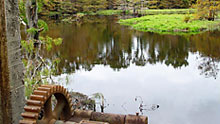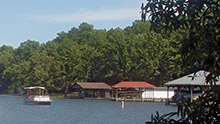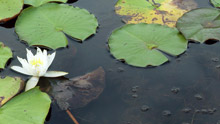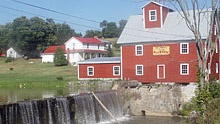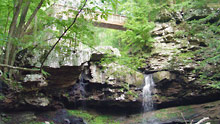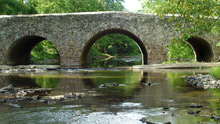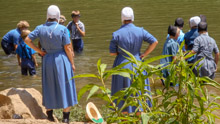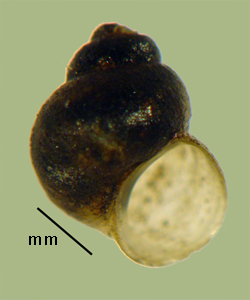> Habitat & Distribution
Somatogyrus pennsylvanicus populations are locally dense but of spotty distribution in the main Susquehanna and Delaware Rivers, together with a few of their higher-quality tributaries. Solid substrate seems to be a key habitat requirement. The snail is typically found in rocky riffles with good flow, often associated with the macrophyte Podostemum. Somatogyrus pennsylvanicus demonstrates non-apparent rarity in our 15-state study area, FWGNA incidence rank I-3*.
> Ecology & Life History
Hydrobioid populations seem to be rather nonspecific grazers of small particles (Dillon 2000: 94-97). They are typically dioecious, the males being characterized by a penis that arises from the neck. Eggs are generally laid singly, attached in a spare capsule to a solid substrate. We are unaware of any good study on any aspect the biology of Somatogyrus.
> Taxonomy & Systematics
Somatogyrus may be confused with several other taxa of plainly-shelled hydrobioids inhabiting North American Atlantic drainages. In contrast to the (much more widespread) Amnicolids, penial morphology in the family Lithoglyphidae (to which Somatogyrus belongs) is simple and unlobed, with just the single duct. Of the two lithoglyphid genera inhabiting American
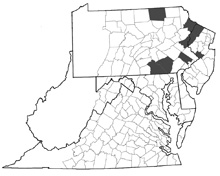 Atlantic drainages (Somatogyrus and Gillia) Somatogyrus bears
the heavier shell and is more commonly associated with rocky midstream
rapids. Burch (1989) divided Somatogyrus into
two subgenera (Walkerilla
and Somatogyrus
s.s.) but later opinions suggest little basis for the distinction
(Thompson 1984).
Atlantic drainages (Somatogyrus and Gillia) Somatogyrus bears
the heavier shell and is more commonly associated with rocky midstream
rapids. Burch (1989) divided Somatogyrus into
two subgenera (Walkerilla
and Somatogyrus
s.s.) but later opinions suggest little basis for the distinction
(Thompson 1984).
Somatogyrus pennsylvanicus was originally described in 1904 from the Susquehanna River at Columbia, PA, and has rarely been collected since (Evans & Ray 2010). Walker distinguished the taxon from his S. virginicus (much more common through the Carolinas and Georgia) as being somewhat larger, less solid, more globose, thin lip, color and especially in the impressed umbilical area, which is one of the most distinctive specific characters. Something seems to have been lost from Walker s text here, which is a shame.
We agree that pennsylvanicus populations do indeed seem to bear lighter and more inflated shells than virginicus populations further south, or indeed populations of the (much older) Somatogyrus integra (Say 1829) inhabiting Ohio drainages immediately west. The biological significance of such distinctions, however, remains an open question.
> Maps and Supplementary Resources
> Essays
- The 1904 description of Somatogyrus pennsylvanicus was touched upon in my 9Nov12 essay reviewing the life and work of Bryant Walker, "Bryant Walker's Sense of Fairness."
- Earlier versions of this website, online until August of 2016, adopted the large, broadly-inclusive concept of the Hydrobiidae (sl) following Kabat & Hershler (1993). More recently the FWGNA project has shifted to the Wilke et al. (2013) classification system, distinguishing a much smaller Hydrobiidae (ss) and elevating many hydrobioid taxa previously ranked as subfamilies to the full family level. For more details, see The Classification of the Hydrobioids.
> References
Burch, J. B. (1989) North
American Freshwater Snails. Malacological Publications,
Hamburg, Michigan. 365 pp.
Dillon,
R.T., Jr. (2000) The Ecology of Freshwater Molluscs.
Cambridge University Press, Cambridge, United Kingdom. 509 pp.
Evans, R. and S. Ray
(2010) Distribution and environmental influences
of freshwater gastropods from lotic systems and springs in
Pennsylvania, USA, with conservation recommendations. Amer.
Malac. Bull. 28: 135 - 150.
Kabat, A.R., and R.
Hershler (1993) The prosobranch snail family Hydrobiidae
(Gastropoda: Rissooidea): review of classification and supraspecific
taxa. Smithsonian Contributions to Zoology 547:1-94.
Thompson, F. (1984)
North American freshwater snail genera of the hydrobiid subfamily
Lithoglyphinae. Malacologia 25: 109-141.
Walker, B.
(1904) New species of Somatogyrus.
Nautilus 17: 133-142.
Wilke T., Haase M., Hershler R.,
Liu H-P., Misof B., Ponder W. (2013)
Pushing short DNA fragments to the limit: Phylogenetic
relationships of hydrobioid gastropods (Caenogastropoda: Rissooidea). Molecular Phylogenetics
and Evolution 66: 715 736.

